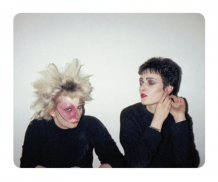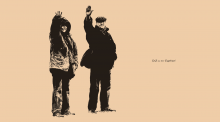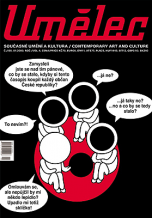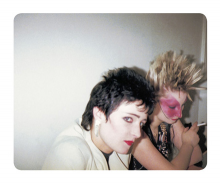| Umělec magazine 2005/1 >> West Goes East: Barbara Benish completes the circle | List of all editions. | ||||||||||||
|
|||||||||||||
West Goes East: Barbara Benish completes the circleUmělec magazine 2005/101.01.2005 Tony Ozuna | interview | en cs |
|||||||||||||
|
In Democracy in America, Tocqueville describes a remarkable scene that he comes across in the wilderness of Alabama in 1831. The European intellectual traveler stumbles across an Indian woman followed by a “Negress” who is holding the hand of a “little white girl of five or six years.” The Indian is described as a noble, “her hair adorned with glass beads,” and the negress is described as a slave in squalid European clothing. The Indian caresses the girl, as the negress vies for the child’s attention. The little white girl displays a feeling of superiority—a strange contrast because of her age and physical weakness. When the group sees Tocqueville with his entourage, across the spring, the atmosphere of the triad is broken. The Indian pushes the girl away and turns into the forest. The negress waits with the girl for Monsieur to approach. Richard Rodriguez’s analysis of this scene in “Brown,” his book of essays on race, proceeds to criticize Tocqueville for being the indulgent intruder--breaking the spell of nature.
This scene is akin to multiculturalism’s debut in world history. Not two, but three civilizations merging at one spot. And not the usual, men merging for a fight, but women merging to caress and care for an innocent child….This is the roots of Europe’s spiritual connection to the Americas. Two and a half centuries later, Barbara Benish, an American artist attempts to revive these spiritual roots between the Old and New World. From 1948 to 1989, not a single American artist exhibited in Czechoslovakia, and both cultures suffered from this situation. Artist and curator, Benish and Czech curator Zdenka Gabalová finally broke this taboo just before the Velvet Revolution. The purpose of the exhibit would be to open up a dialog between the two countries. It was a response to Kundera’s complaint in 1982: “We have replaced dialog with ideological struggle.” After three years of organization, in August 1989, 16 young L.A. artists began the trans-cultural dialog in an “official art space,” in Prague, at the People’s House in Karlín, the Gallery for Youth, and Gong. In exchange, eleven Czech artists were permitted to exhibit in L.A., at Otis/Parsons, the Santa Monica Museum of Art, and Arroyo Arts Gallery. Of course, Benish and Gabalová expected artists’ work and even their lives to be affected by this opportunity (especially on the Czech end), when they organized the exhibition. Ironically, however, Benish’s life seems to have been affected more than anyone else. Benish studied at U.C.L.A., Mexico’s Instituto de las Bellas Artes, the University of Hawaii (Art/Ethnology), the Royal Academy of Stockholm, and Claremont Graduate School. When she first visited Czechoslovakia in 1979, she says the poppy flowers along the roadside mesmerized her, as did the old men in the pubs. She has Czech heritage, and heard Czech at home, growing up in Newport Beach, California. On her first visit to Bohemia (at 17), she says, “I felt instantly at home, even then. Staying here was a natural step; my connection here is just one of those things that is unexplainable in words.” She returned to Prague in 1993 on a Fulbright Scholarship and never went back. Benish says, “History is our book of humanity, for better or worse. As long as one pays attention to whom the author(s) are, then it can be an instrumental source.” So for her, moving to Europe was “more like taking on the responsibility of that history,” which she feels Americans are very good at repressing (for example, the history of Native Americans). Some of her most provocative work reflects this responsibility to the shared histories of Europe and the Americas. In 1992, in Prague’s Powder Gate, her sculpture-installation, Encuentro (Encounter) created a mystical meeting point of Native-American artifacts in Central Europe. The Powder Gate is a historic gothic tower, an ancient entrance to Prague’s Old Town. Inside the tower, she constructed a pyramid of rusted scaffolding, representing the swords of Spanish Conquistadors; hanging from this were glass slides noting solar phenomenon and the astronomical belief systems of the Chumash tribe, natives of the California coastal area. Other cards were decorated with Indian, Greek and Roman motifs. In the lower part of the tower were obscured symbols of modern American culture: consumerism and media signs. Completing the spiral at the bottom of the tower were empty glass slides that mirrored the clear light and colors of the stained glass windows of the room. Encuentro introduced obscure, though highly advanced native-American astronomy to the homeland of European alchemy; the natural light from the tower’s stained glass windows welcomed and nourished the ancient symbols of knowledge from the New World. In 1995, Benish “occupied” the symbolic Czech space, Manes, with Water Enough for One Root, where she installed large silky “flowers” on the ground and billowing parachute-like ones above suspended from the ceiling. Natural light from the windows was critical for the objects, while atmospheric music by Czech-Japanese composer Philip Noshiro filled the room. These were provocative shows because of their emphasis on culture clash; however, she says that the response from locals can be difficult to fathom. “It’s always difficult for me to judge how my work is received here, as the climate is not conducive to dialog, especially with a foreign woman. There is probably some level of competition involved, and the lack of a history of talking about issues out loud here sometimes makes me think I put my work out there into this big black hole. But then something happens, like the time I was teaching….[in Brno] and one student said she had seen all my shows and she could talk in depth about each installation.” In 1997, Benish moved with her family to the Sumava Mountains near the German border. Her studio and family are there; that’s all she needs. Since then she has not exhibited often in Prague; her only show in this country, in 2003, was in Pilsen (The Bride in the Enclosed Garden, City Gallery. For her, this is a natural development: when she lived in Prague, she was active in the Prague art scene. Now that she’s in southern Bohemia, she’s more active there. “Showing my work regionally is part of my commitment to the idea of community,” she says. “A lot of artists at a certain point in their careers stop doing this; I hope I can continue doing small, local shows as it is part of that outreach beyond the normal limits of the art world, and I like that.” According to artist, Ben Shahn, “The public function of art has always been one of creating a community. Benish’s work is exceptional not because she has dislodged herself from one community into another (from the Pacific coast to the “coast” of Bohemia), nor altered her self-identity (she identifies herself as both a Czech and American artist), but wherever she is, her art has consistently created an opportunity for thoughtful dialog with not only the community that it exists in, but also its primeval history, genius loci, myths and spirits, and her long-term desire to connect the histories of the New and Old World is pioneering. She is committed to her community; but this is not to say that she does not exhibit beyond south Bohemia. Last year, she showed in Paris, Los Angeles, Italy, and she’s now preparing for a show in Chicago. Her recent work represents an even deeper form of community: marriage, motherhood and her children. Her Bride in the Enclosed Garden represents contemplation (meditation), a place for creative process, and the sculpture of the bride is both Male and Female. In an interview from the catalog for the Bride, Benish discusses gender and sex, celebration of the female body, and its power and capacity of bringing new life to the world. “As a female artist, I naturally have always been addressing these issues. At the beginning of my career, the work is much more about sexual energy. Now I am a middle-aged artist, a mother—so the energy is different. The body is changing; it’s [the bride exhibit] about being a lover, but also a mother, a wife....” In this exhibit there were also delicate Mother-Daughter drawings, which originated in collaboration with her oldest daughter. One would start drawing and the other would continue and contribute her part. Benish says, “Their [her children’s] creativity has re-inspired and nurtured my own. To watch them draw is like seeing that film of Picasso doing the drawings on glass; total abandonment, spontaneity and pleasure. And art is just a matter of staying open to such things, is it not?” Benish’s community is vast. Though she’s been a mother of two children for eight years, she has “taught, lectured, and created enough work to exhibit in over 30 exhibitions, including five solo shows.” Her work is in museums and collections around the world, including the Getty in Los Angeles, which overlooks the coast at the edge of the western world. Ironically, she wrote in 1990, “Czechoslovakia and California, each at the edge of the so-called western world, looks east and sees the other. When Walt Whitman looked west from California’s shores, he completed the circle, ending up back in the east, ‘Now I face home again, very pleased and joyous.’” Benish, growing up on the coast also looked west from her shore, and ended up in the east. She ended up much further than Whitman, and with a bigger clan; but all the same—she has completed the circle, returned “home again” and she seems very pleased and joyous about this decision.
01.01.2005
Recommended articles
|
|||||||||||||
|
04.02.2020 10:17
Letošní 50. ročník Art Basel přilákal celkem 93 000 návštěvníků a sběratelů z 80 zemí světa. 290 prémiových galerií představilo umělecká díla od počátku 20. století až po současnost. Hlavní sektor přehlídky, tradičně v prvním patře výstavního prostoru, představil 232 předních galerií z celého světa nabízející umění nejvyšší kvality. Veletrh ukázal vzestupný trend prodeje prostřednictvím galerií jak soukromým sbírkám, tak i institucím. Kromě hlavního veletrhu stály za návštěvu i ty přidružené: Volta, Liste a Photo Basel, k tomu doprovodné programy a výstavy v místních institucích, které kvalitou daleko přesahují hranice města tj. Kunsthalle Basel, Kunstmuseum, Tinguely muzeum nebo Fondation Beyeler.
|




































 We Are Rising National Gallery For You! Go to Kyjov by Krásná Lípa no.37.
We Are Rising National Gallery For You! Go to Kyjov by Krásná Lípa no.37.
Comments
There are currently no comments.Add new comment